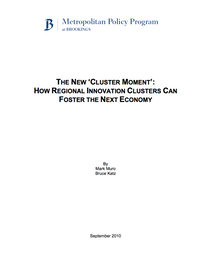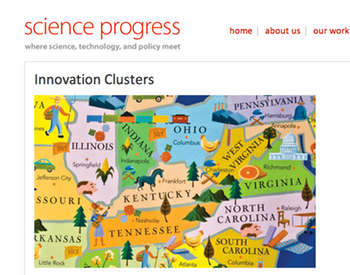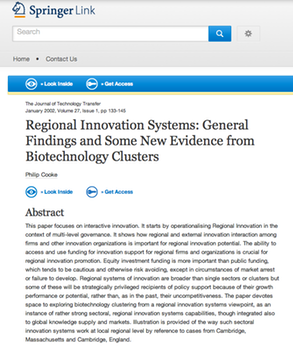
The New "Cluster Movement": How Regional Innovation Clusters Can Foster the Next Economy
This page provides just a few resources for you to get started on research for your regional innovation cluster, beginning with a white paper written by Mark Muro and Bruce Katz for the Brookings Institution in 2010.

EXECUTIVE SUMMARY
Twenty years after Harvard Business School professor Michael Porter introduced the concept to the policy community and 10 years after its wide state adoption, clusters—geographic concentrations of interconnected firms and supporting or coordinating organizations—have reemerged as a key tool and rubric in Washington and in the nation’s economic regions.
After a decade of delay, the executive branch and Congress have joined state and local policymakers in embracing “regional innovation clusters” (RICs) as a framework for structuring the nation’s economic development activities.
At the state level, governors and gubernatorial candidates of both parties are maintaining or stepping up their longstanding interest.
And additionally, a broad range of business leaders, mainstream commentators, and policy analysts have been calling in the wake of the recent recession for a different kind of growth model that depends less on bubbles and consumption and more on the production of lasting value in metropolitan economies and the super-productive clusters within them.
All of which, at a moment of deep economic uncertainty, makes it appropriate to revisit the cluster paradigm and consider its special relevance at a moment of deep economic uncertainty, fiscal crisis, partisan gridlock, and necessary governance reform.
What explains clusters’ renewed popularity? To be sure, some of the concept’s new and bipartisan relevance owes to its sound non-partisan concern with the mechanics of value-creation in local economies, whether metropolitan or rural, high-tech or manufacturing. And it’s true that as a matter of policy action clusters—ranging from the famous Silicon Valley technology cluster to the Vermont cheesemaking cluster—are all about synergies and efficiencies, and don’t tend to cost too much.
But what is most timely beyond all that may be the possibility that the new prominence of regional innovation clusters reflects something deeper: a positive interest in locating a more grounded, realistic way to think about the economy and development efforts so as to put both on a more productive footing.
In this setting, the new cluster discussions redirect attention, analysis, and policymaking to the more grounded, day-to-day interactions by which real companies in real places complete transactions, share technologies, develop innovations, start new businesses—and yes, create jobs and locate workers. To that extent, clusters—whether of airplane manufacturing in Wichita or cleantech in Colorado or biomedical innovation in Cleveland—represent an antidote to the nation’s recent economic history of bubbles and consumption and also a framework for recognizing and bolstering the real-world variety and dynamism of regional economies. Hot spots of productivity and collaboration as well as competition, clusters are the locations most likely to deliver a new economy that is export-oriented, lower carbon, innovation-driven and so opportunity and prosperity rich. MORE
Why Regional Innovation Clusters Should Not Be Demonized

Igniting Innovation through RICs can be a good thing if done right
By: G. Nagesh Rao
Over the past few years, the mere utterance of the term “Regional Innovation Clusters” (RICs) has either ginned up folks or struck a gut-wrenching chord within the startup and technology world. No fiercer critic has emerged than Vivek Wadhwa, who has been opining thoughtfully on his belief that government sponsored Regional Innovation Clusters, are doomed for failure. He believes the current strategy of constructing an incubator in an area with cheap real-estate and sprinkling a few smart folks in the area to “create magic” is insufficient. READ MORE

How can regions participate in and take advantage of today's knowledge-based innovation economy? This website provides tools to facilitate relevant insights and help answer the fundamental questions underlying regional development in today's changing economy.
The purpose of these tools is to help a region guide strategic discussions about where to invest scarce resources to build prosperity for the next generation. More specifically, these tools enable regional leaders to focus on 2 sets of core assets that create prosperity: brainpower and innovation.
READ MORE
Science Progress:
Innovation Clusters

In regions around the country, clusters of universities and high-tech companies partner with local and regional governments to boost tech-based economic growth and create good jobs. The two best examples are Silicon Valley, the hotbed of computer technology in northern California, and the metropolitan Boston area connected by Route 128, which is a nexus of biotechnology research and development. For a primer on innovation clusters, see our “Regional Centers of Innovation 101.”
The federal government provides large sums of funding for basic scientific research, and boasts a variety of different programs to help companies and state and local governments prepare executives and workers for employment at young, innovative companies seeking to commercialize this research. But the federal government lacks a comprehensive approach for innovation policy. What’s needed is today is a clear-eyed blueprint for developing more innovative clusters around the country that links together federal programs, academic institutions, companies, and local and regional policymakers. In this series, Science Progress will feature bold ideas from innovation experts across the nation for how the Obama administration can develop an effective innovation policy that creates jobs, enables economic mobility, enhances science, and grows the county’s competitiveness. READ MORE
Regional Innovation Systems: General Findings and some New Evidence from Biotechnology Clusters

Abstract
This paper focuses on interactive innovation. It starts by operationalising Regional Innovation in the context of multi-level governance. It shows how regional and external innovation interaction among firms and other innovation organizations is important for regional innovation potential. The ability to access and use funding for innovation support for regional firms and organizations is crucial for regional innovation promotion. Equity investment funding is more important than public funding, which tends to be cautious and otherwise risk avoiding, except in circumstances of market arrest or failure to develop. Regional systems of innovation are broader than single sectors or clusters but some of these will be strategically privileged recipients of policy support because of their growth performance or potential, rather than, as in the past, their uncompetitiveness. The paper devotes space to exploring biotechnology clustering from a regional innovation systems viewpoint, as an instance of rather strong sectoral, regional innovation systems capabilities, though integrated also to global knowledge supply and markets. Illustration is provided of the way such sectoral innovation systems work at local regional level by reference to cases from Cambridge, Massachusetts and Cambridge, England. READ MORE j